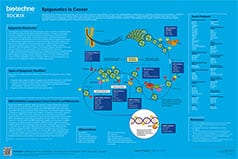Poly(ADP-ribose) Glycohydrolase
Poly(ADP-ribose) Glycohydrolase (PARG) is an enzyme responsible for the hydrolysis of ribose-ribose bonds on poly(ADP-ribose) (PAR)-ylated proteins. This enzyme counteracts the action of poly(ADP-ribose) polymerase (PARP) and is involved in DNA repair mechanisms following oxidative stress and in cancer.
Poly(ADP-ribose) Glycohydrolase Inhibitors |
|
|---|---|
| Cat. No. | Product Name / Activity |
| 7007 | PDD 00017238 |
| High affinity and potent PARG inhibitor | |
| 7006 | PDD 00017272 |
| Potent PARG inhibitor | |
| 5952 | PDD 00017273 |
| Potent and selective PARG inhibitor; cell permeable | |
PARG (E.C. 3.2.1.143) is encoded by the PARG gene, which has several transcript variants encoding different isoforms of the enzyme. The PARG gene variants produce proteins of different lengths, which show distinct tissue specificity and subcellular distribution; PARG111 displays nuclear localization and is responsible for degradation of PARP1/2-derived PARylation. PARG102 and PARG99 are found in the cytoplasm and perinuclear regions and regulate PAR-induced cytoplasmic granule production and protein aggregation.
Addition of PAR residues to proteins is a form of post-translational modification and the accumulation of PAR chains is thought to be a cell death signal. PAR is added to proteins by PARPs and PARG hydrolyzes ribose-ribose bonds to remove PAR. However, the catalytic efficiency of PARG is reduced when there are less than 4 ADP-ribose units in the chain, and PARG cannot remove the last unit from PARylated proteins.
PARG is particularly important for DNA repair following cellular oxidative stress. PARG is recruited to sites of DNA damage where it plays a critical role in preserving the integrity of replication forks under replicative stress conditions. When single-strand breaks occur PARPs recruit scaffold proteins to the site of DNA damage, while PARG regulates the dissociation of these proteins and has been shown to colocalize with replication forks. Its role in DNA damage repair means that PARG is a potential target for drugs to treat cancer. Indeed, oxidative stress and genomic instability of cancer cells sensitizes them to the action of PARG inhibitors.

Figure 1: Structure of human PARG. Structure taken from Protein Data Bank, PDBID: 6OA1. Houl et al (2004) Selective small molecule PARG inhibitor causes replication fork stalling and cancer cell death. Nat Commun 10: 5654-5654
External sources of pharmacological information for Poly(ADP-ribose) Glycohydrolase :
Literature for Poly(ADP-ribose) Glycohydrolase
Tocris offers the following scientific literature for Poly(ADP-ribose) Glycohydrolase to showcase our products. We invite you to request* your copy today!
*Please note that Tocris will only send literature to established scientific business / institute addresses.
Epigenetics in Cancer Poster
This poster summarizes the main epigenetic targets in cancer. The dysregulation of epigenetic modifications has been shown to result in oncogenesis and cancer progression. Unlike genetic mutations, epigenetic alterations are considered to be reversible and thus make promising therapeutic targets.
